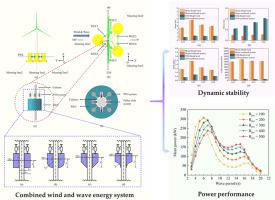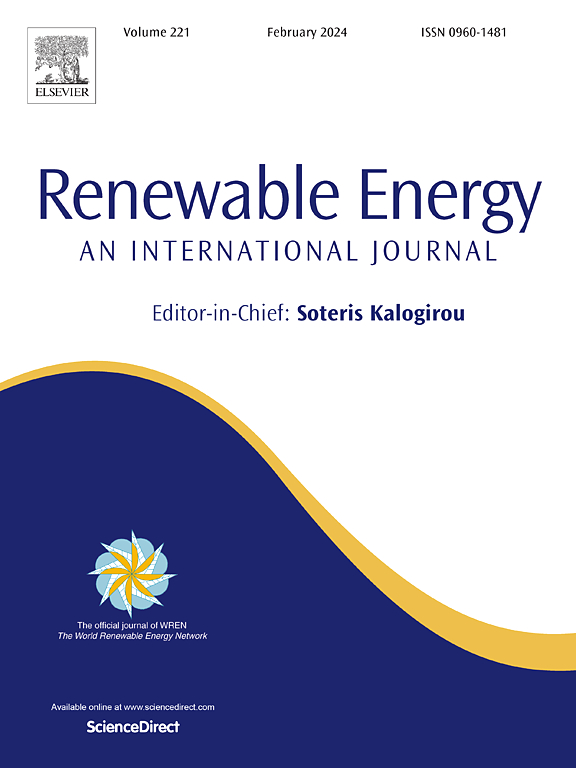Dynamic response and power performance of a combined semi-submersible floating wind turbine and point absorber wave energy converter array
IF 9.1
1区 工程技术
Q1 ENERGY & FUELS
引用次数: 0
Abstract
With the global demand for renewable energy rising, offshore renewable energy development has gained more attention. The combination of wind and wave energy is a new trend. Ensuring stability in combined systems is crucial for efficiency of absorbing energy. A novel combined wind and wave energy system with a semi-submersible floating wind turbine (FWT) and an array of six torus-shaped point absorber wave energy converters (WECs) is proposed. The dynamic response of combined system is investigated using 3D potential flow theory by comparing to the original system. The effects of power take-off (PTO) damping, WEC float shape and seasonal variation on the dynamic response and power performance of combined system are studied. The results show that the addition of WEC array improves the stability and power production of combined system. Meanwhile, the total power of combined system is approximately 2.5%–6.5 % higher than that of original system. PTO damping mainly affects the heave motion of combined system. As PTO damping increases, the first peak of mean power of WEC array shifts towards the long period, while the second peak of that shifts towards the short period. The conical-bottom WEC generates the most power compared to the flat-bottom WEC, hemispherical-bottom WEC and concave-bottom WEC. The combined system generates the most power in winter, and the total annual electricity output can be up to 2.99 × 104 MWh.

半潜式浮动风力涡轮机和点吸收器波能转换器组合阵列的动态响应和功率性能
随着全球对可再生能源需求的不断增长,近海可再生能源的开发受到越来越多的关注。风能和波浪能的结合是一种新趋势。确保组合系统的稳定性对于提高吸收能量的效率至关重要。本文提出了一种新型风能和波浪能组合系统,该系统由一台半潜式浮动风力涡轮机(FWT)和六个环形点吸收波能转换器(WECs)组成。通过与原始系统进行比较,利用三维势流理论研究了组合系统的动态响应。研究了功率输出(PTO)阻尼、波浪能转换器浮子形状和季节变化对组合系统动态响应和功率性能的影响。结果表明,增加风电机组阵列可提高组合系统的稳定性和发电量。同时,组合系统的总功率比原系统高出约 2.5%-6.5 %。PTO 阻尼主要影响组合系统的摆动。随着 PTO 阻尼的增加,水力发电阵列平均功率的第一个峰值向长周期移动,而第二个峰值向短周期移动。与平底式水力发电阵列、半球形水力发电阵列和凹底式水力发电阵列相比,锥底式水力发电阵列产生的功率最大。组合系统在冬季发电量最大,年总发电量可达 2.99 × 104 兆瓦时。
本文章由计算机程序翻译,如有差异,请以英文原文为准。
求助全文
约1分钟内获得全文
求助全文
来源期刊

Renewable Energy
工程技术-能源与燃料
CiteScore
18.40
自引率
9.20%
发文量
1955
审稿时长
6.6 months
期刊介绍:
Renewable Energy journal is dedicated to advancing knowledge and disseminating insights on various topics and technologies within renewable energy systems and components. Our mission is to support researchers, engineers, economists, manufacturers, NGOs, associations, and societies in staying updated on new developments in their respective fields and applying alternative energy solutions to current practices.
As an international, multidisciplinary journal in renewable energy engineering and research, we strive to be a premier peer-reviewed platform and a trusted source of original research and reviews in the field of renewable energy. Join us in our endeavor to drive innovation and progress in sustainable energy solutions.
 求助内容:
求助内容: 应助结果提醒方式:
应助结果提醒方式:


